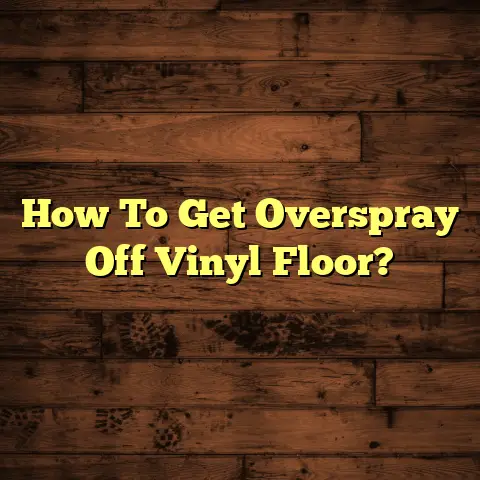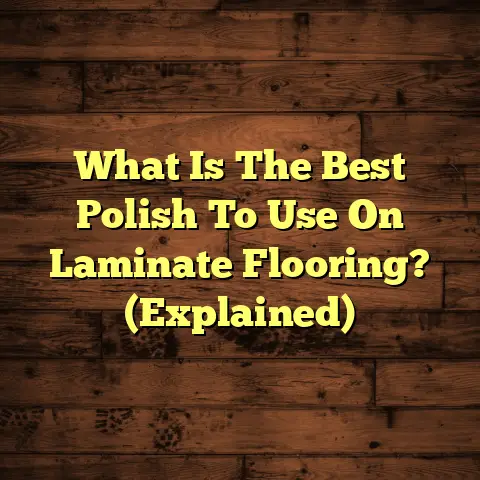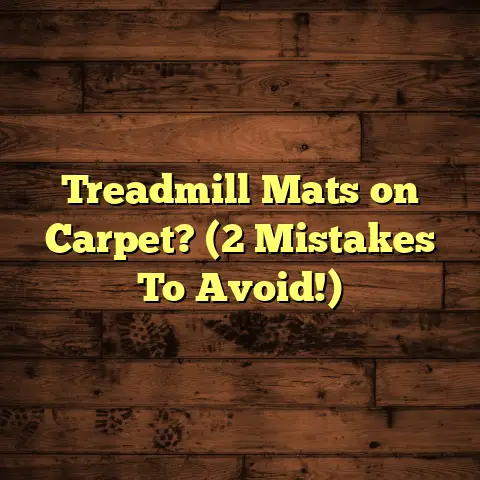Remove Floor Glue From Wood? (2 Pro Secrets!)
We’re not just talking about any old removal; we’re going eco-friendly. Why? Because I believe we can tackle home improvement projects without trashing the planet. Plus, who wants to breathe in nasty chemicals?
Floor glue is everywhere, lurking beneath laminate, vinyl, and even hardwood floors. It’s meant to hold tight, but when it’s time to replace that old flooring, that glue becomes your nemesis. Many homeowners face the frustrating task of removing old floors without damaging the beautiful wood underneath.
I’m here to tell you it’s possible! I’m going to share two pro secrets that are not only effective but also kind to our environment. So, grab your gloves, and let’s get started!
Section 1: Understanding Floor Glue
Before we start ripping and scraping, let’s understand what we’re up against. Floor glue isn’t just one thing; it comes in different flavors, each with its own personality (and level of stickiness!).
Types of Floor Glue
Over my years I have encountered lots of types of glue. Here are the 3 most common types of floor glue:
-
Water-Based: These are the friendliest of the bunch. They’re low in VOCs (Volatile Organic Compounds), making them a greener choice. They’re great for porous materials like wood and some types of vinyl.
-
Solvent-Based: These are the heavy-duty adhesives. They offer a strong bond and are water-resistant. However, they contain harsh chemicals and require proper ventilation. Think of these as the “big guns” when other glues won’t do.
-
Pressure-Sensitive: These adhesives are often found on the back of peel-and-stick tiles or planks. They adhere with pressure and can be surprisingly tenacious.
The chemical composition of these glues varies. Water-based glues often contain polymers and resins that create a flexible bond. Solvent-based glues use strong chemical solvents to dissolve and bind materials. Pressure-sensitive adhesives rely on a tacky surface that adheres upon contact.
All these glues bond with wood through a combination of mechanical and chemical adhesion. The glue seeps into the pores of the wood, creating a physical grip. At the same time, chemical reactions between the glue and the wood surface create a strong bond.
Impact on Wood
Floor glue, while effective at holding things down, can be a real pain for wooden floors. If not removed properly, it can lead to several types of damage:
- Surface Damage: Aggressive removal techniques can scratch, gouge, or strip the wood surface.
- Chemical Damage: Harsh solvents can discolor or weaken the wood fibers.
- Moisture Damage: Some glues trap moisture, leading to rot or mold growth.
I’ve seen floors ruined by improper glue removal. The key is to be patient and use the right methods.
Signs of Floor Glue Presence
How do you know if you’re dealing with floor glue? Here are a few telltale signs:
- Uneven Surfaces: Bumps or ridges under the new flooring can indicate old glue residue.
- Peeling: If the new flooring is peeling up, especially at the edges, old glue could be the culprit.
- Adhesive Residue: During floor removal, you might see a sticky, gummy substance clinging to the subfloor.
- Discoloration: Dark or stained patches on the subfloor can indicate glue residue.
If you spot any of these signs, it’s time to prepare for glue removal.
Section 2: Pro Secret #1 – Eco-Friendly Glue Removal Techniques
Okay, let’s get to the good stuff! My first pro secret focuses on eco-friendly techniques for removing floor glue. This method is perfect for those who want to protect their health and the environment.
Method Overview
This method relies on softening the glue with heat or eco-friendly solvents and then gently scraping it away. It’s a bit more labor-intensive than other methods, but it’s worth it for the peace of mind.
Step-by-Step Process
Let’s break down the process into manageable steps:
Preparation
First, gather your supplies. You’ll need:
- Heat Gun: A heat gun will help soften the glue. Be careful not to overheat the wood.
- Scrapers: Use a variety of scrapers, including plastic and metal ones. Plastic scrapers are less likely to damage the wood.
- Eco-Friendly Solvent: Look for a solvent specifically designed for removing adhesive. Make sure it’s non-toxic and biodegradable. Some popular options include citrus-based cleaners or soy-based solvents.
- Protective Gear: Wear gloves and eye protection to protect yourself from the glue and solvents.
- Ventilation: Open windows and doors to ensure good ventilation.
Application
Now, let’s get to work:
- Heat Application: If using a heat gun, hold it a few inches away from the glue and move it back and forth. Don’t hold it in one spot for too long, or you could scorch the wood. The goal is to soften the glue, not burn it.
- Solvent Application: If using a solvent, apply it liberally to the glue residue. Let it sit for the recommended time (usually 15-30 minutes) to allow it to penetrate and soften the glue.
- Combination: For really stubborn glue, you can combine heat and solvent. Apply the solvent first, then use the heat gun to warm it up.
Removal
Once the glue is softened, it’s time to start scraping:
- Start with a Plastic Scraper: Gently scrape the softened glue away. Use a firm, even pressure. Avoid gouging or scratching the wood.
- Switch to a Metal Scraper (If Needed): If the plastic scraper isn’t doing the job, try a metal scraper. Be extra careful to avoid damaging the wood. Hold the scraper at a low angle and use short, controlled strokes.
- Work in Sections: Focus on small sections at a time. Reapply heat or solvent as needed to keep the glue soft.
- Patience is Key: This process can be time-consuming, so be patient. Don’t try to rush it, or you could end up damaging the wood.
Cleaning Up
After you’ve removed the glue, it’s time to clean up the surface:
- Wipe with a Damp Cloth: Use a damp cloth to remove any remaining residue.
- Use an Eco-Friendly Cleaner: For stubborn residue, use an eco-friendly cleaner specifically designed for wood.
- Dry Thoroughly: Make sure the wood is completely dry before applying any new flooring or finish.
Advantages of Eco-Friendly Methods
Why choose eco-friendly methods? Here are a few compelling reasons:
- Safety: Non-toxic products are safer for you, your family, and your pets. You won’t have to worry about breathing in harmful fumes.
- Environmental Protection: Eco-friendly solvents are biodegradable and won’t pollute the air or water.
- Wood Preservation: Gentle methods are less likely to damage the wood, preserving its natural beauty and integrity.
I always recommend eco-friendly methods whenever possible. They’re a win-win for everyone.
Section 3: Pro Secret #2 – Advanced Tools and Techniques
Sometimes, eco-friendly methods just aren’t enough. For those super-stubborn glue remnants, you might need to bring out the big guns. My second pro secret focuses on advanced tools and techniques for tougher glue removal.
Method Overview
This method involves using specialized tools and techniques to mechanically remove the glue. It’s more aggressive than the eco-friendly method, so it’s important to use caution and skill.
Tool Breakdown
Here are a few specialized tools that can make glue removal easier:
- Oscillating Multi-Tool: This versatile tool can be fitted with a scraper blade to remove glue. It’s great for getting into tight corners and along edges.
- Floor Scraper: A long-handled floor scraper can be used to remove large areas of glue. It’s more efficient than a hand scraper for big jobs.
- Sander: A sander can be used to smooth out the surface after glue removal. Use a fine-grit sandpaper to avoid damaging the wood.
- Glue Remover Attachment: Some manufacturers make glue remover attachments that can be used with your power drill to remove glue faster.
Step-by-Step Process
Let’s break down the process into manageable steps:
Preparation
First, gather your supplies. You’ll need:
- Your Chosen Tool: Select the tool that’s best suited for the job.
- Scraper Blades or Sandpaper: Make sure you have the right blades or sandpaper for your tool.
- Solvent (Optional): You can use a solvent in combination with the tools to soften the glue.
- Protective Gear: Wear goggles, gloves, and a dust mask to protect yourself from debris and chemicals.
- Ventilation: Open windows and doors to ensure good ventilation.
Application
Now, let’s get to work:
- Apply Solvent (If Using): If using a solvent, apply it liberally to the glue residue. Let it sit for the recommended time to allow it to penetrate and soften the glue.
- Use the Oscillating Multi-Tool: Attach a scraper blade to the oscillating multi-tool. Hold the tool at a low angle and use short, controlled strokes to remove the glue. Be careful not to gouge the wood.
- Use the Floor Scraper: If using a floor scraper, hold it at a low angle and push it across the surface to remove the glue. Use a firm, even pressure.
- Use the Sander: After you’ve removed the glue, use a sander to smooth out the surface. Start with a medium-grit sandpaper and then switch to a fine-grit sandpaper. Be careful not to sand too much, or you could damage the wood.
- Glue Remover Attachment: If using a glue remover attachment, follow the manufacturer’s instructions. Be careful not to apply too much pressure, or you could damage the wood.
Technique
Here are a few advanced techniques to help you get the best results:
- Use Heat and Solvent: Combine heat and solvent with mechanical tools for optimal results. Apply the solvent first, then use a heat gun to warm it up. This will help to soften the glue and make it easier to remove.
- Work in Sections: Focus on small sections at a time. Reapply solvent or heat as needed to keep the glue soft.
- Use a Vacuum: Use a vacuum to remove debris as you work. This will help you see what you’re doing and prevent the debris from scratching the wood.
Finishing Touches
After you’ve removed the glue, it’s time to add the finishing touches:
- Sand the Wood: Sand the wood to smooth out any imperfections. Start with a medium-grit sandpaper and then switch to a fine-grit sandpaper.
- Clean the Surface: Clean the surface with a damp cloth to remove any remaining dust.
- Apply a Finish: Apply a finish to protect the wood and enhance its natural beauty. Choose an eco-friendly finish that’s appropriate for your wood type.
Pros and Cons of Advanced Techniques
Advanced techniques can be effective, but they also have their drawbacks:
Pros:
- Faster Removal: Mechanical tools can remove glue much faster than manual methods.
- More Effective: Advanced techniques can remove even the most stubborn glue remnants.
- Versatile: Specialized tools can be used in a variety of situations.
Cons:
- Risk of Damage: Aggressive methods can damage the wood if not used carefully.
- Skill Required: Advanced techniques require skill and experience.
- Cost: Specialized tools can be expensive.
Section 4: Post-Removal Care for Wood Flooring
You’ve battled the glue and emerged victorious! But the job isn’t quite done. Proper post-removal care is crucial to ensure your wood flooring looks its best and lasts for years to come.
Inspection
First, take a close look at the wood surface. Look for:
- Scratches: Check for any scratches or gouges caused by the removal process.
- Dents: Look for dents or impressions in the wood.
- Discoloration: Check for any discoloration or staining caused by the glue or solvents.
- Loose Boards: Make sure all the boards are firmly attached to the subfloor.
Repairing Damage
If you find any damage, don’t worry! Most minor damage can be repaired with a few simple steps:
- Filling Scratches and Dents: Use a wood filler to fill in any scratches or dents. Choose a wood filler that matches the color of your wood. Apply the filler with a putty knife and let it dry completely. Then, sand it smooth with fine-grit sandpaper.
- Replacing Damaged Boards: If a board is severely damaged, you may need to replace it. Use a chisel and hammer to remove the damaged board. Then, install a new board using construction adhesive and finish nails.
- Addressing Discoloration: For minor discoloration, you can try sanding the affected area. For more severe discoloration, you may need to use a wood bleach. Be careful when using wood bleach, as it can damage the wood if not used properly.
Finishing Options
After you’ve repaired any damage, it’s time to apply a finish. A finish will protect the wood and enhance its natural beauty. Here are a few eco-friendly finishing options:
- Water-Based Polyurethane: This is a durable and low-VOC finish that’s easy to apply. It provides a clear, protective coating that resists scratches and stains.
- VOC Content: Typically less than 250 g/L.
- Durability: Good resistance to wear and tear, suitable for high-traffic areas.
- Oil-Based Polyurethane: While less eco-friendly than water-based options, oil-based polyurethane provides a durable and water-resistant finish. It has a higher VOC content but offers excellent protection.
- VOC Content: Can exceed 450 g/L.
- Durability: Excellent water resistance and long-lasting protection.
- Penetrating Oil Finishes: These finishes penetrate the wood and harden from within. They provide a natural look and feel and are easy to repair.
- VOC Content: Varies, but low-VOC options are available.
- Durability: Requires regular maintenance but offers a natural look and feel.
- Wax Finishes: Wax finishes provide a soft, lustrous sheen. They’re easy to apply and maintain, but they’re not as durable as polyurethane finishes.
- VOC Content: Very low, often made from natural ingredients.
- Durability: Best for low-traffic areas due to lower resistance to wear.
Conclusion
We’ve covered a lot of ground! You now have two pro secrets for removing floor glue from wood: eco-friendly techniques and advanced tools.
Remember, the key takeaways are:
- Understanding the Glue: Know what type of glue you’re dealing with.
- Choosing the Right Method: Select the method that’s best suited for the job.
- Being Patient: Don’t rush the process, or you could damage the wood.
- Taking Precautions: Wear protective gear and ensure good ventilation.
- Finishing Touches: Repair any damage and apply a finish to protect the wood.
By using eco-friendly methods, you can remove floor glue without harming the environment or your health. You’ll also preserve the integrity of your wood floor, ensuring it looks beautiful for years to come.
So, go forth and conquer that floor glue! I’m confident you can tackle your flooring projects with confidence and achieve amazing results.
Call to Action
Now it’s your turn! Have you ever tackled a floor glue removal project? What tips and tricks did you learn along the way? Share your experiences and any additional eco-friendly tips you might have in the comments below.
And if you’re hungry for more home improvement knowledge, be sure to explore my other articles on flooring, remodeling, and DIY projects. Together, we can create beautiful and sustainable homes!
Happy renovating!





